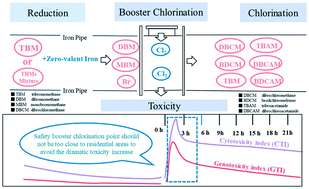Emerging investigator series: formation of brominated haloacetamides from trihalomethanes during zero-valent iron reduction and subsequent booster chlorination in drinking water distribution†
Abstract
Iron materials and booster chlorination in drinking water distribution pipe networks could impact disinfection by-product (DBP) transformation. This study investigated trihalomethane (THM) mixture degradation and brominated haloacetamide (Br-HAM) formation during zero-valent iron (ZVI) reduction and booster chlorination. The toxicity change resulting from the formation of the higher toxicity species, Br-HAMs, in drinking water distribution systems was explored for the first time. The results from tribromomethane (TBM) reduction experiments showed that the ZVI dosage and the water matrix enhanced TBM reduction by ZVI. The higher the ZVI dosage and the lower the pH, the more TBM was reduced by ZVI. Coexisting ions, SO42− and HCO3−, promoted TBM reduction slightly. The humic acid-like component of natural organic matter was conjectured to dominate the coordination complex generation through reacting with Fe2+ and therefore greatly inhibited TBM reduction. During the subsequent booster chlorination, brominated THM yields increased with time, while a sharp increase in Br-HAMs was observed before it decreased. Under the drinking water distribution system conditions with an environmentally relevant concentration ratio of the THM mixture, most THMs were reduced greatly by ZVI. Subsequently, the following booster chlorination produced Br-THMs and Br-HAMs instead of haloacetonitriles (HANs). Generally, THMs slightly increased with time (except for trichloromethane [TCM]), while Br-HAMs exhibited a sharp formation at 0.5 h after booster chlorination and then decreased gradually. This resulted in an increase in the cytotoxicity and genotoxicity index, indicating that booster chlorination should not be too close to residential areas in iron pipe networks. Overall, the toxicity risk caused by Br-HAM formation through ZVI reduction and booster chlorination increased.

- This article is part of the themed collection: Emerging Investigator Series


 Please wait while we load your content...
Please wait while we load your content...